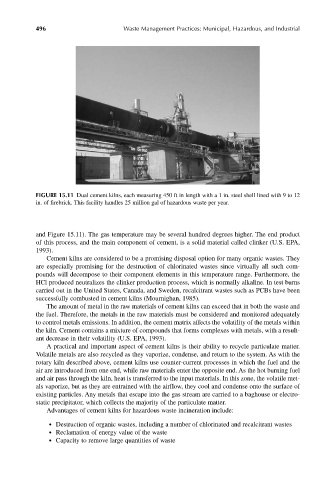Page 525 - Materials Chemistry, Second Edition
P. 525
CAT3525_C15.qxd 1/27/2005 12:40 PM Page 496
496 Waste Management Practices: Municipal, Hazardous, and Industrial
FIGURE 15.11 Dual cement kilns, each measuring 450 ft in length with a 1 in. steel shell lined with 9 to 12
in. of firebrick. This facility handles 25 million gal of hazardous waste per year.
and Figure 15.11). The gas temperature may be several hundred degrees higher. The end product
of this process, and the main component of cement, is a solid material called clinker (U.S. EPA,
1993).
Cement kilns are considered to be a promising disposal option for many organic wastes. They
are especially promising for the destruction of chlorinated wastes since virtually all such com-
pounds will decompose to their component elements in this temperature range. Furthermore, the
HCl produced neutralizes the clinker production process, which is normally alkaline. In test burns
carried out in the United States, Canada, and Sweden, recalcitrant wastes such as PCBs have been
successfully combusted in cement kilns (Mournighan, 1985).
The amount of metal in the raw materials of cement kilns can exceed that in both the waste and
the fuel. Therefore, the metals in the raw materials must be considered and monitored adequately
to control metals emissions. In addition, the cement matrix affects the volatility of the metals within
the kiln. Cement contains a mixture of compounds that forms complexes with metals, with a result-
ant decrease in their volatility (U.S. EPA, 1993).
A practical and important aspect of cement kilns is their ability to recycle particulate matter.
Volatile metals are also recycled as they vaporize, condense, and return to the system. As with the
rotary kiln described above, cement kilns use counter-current processes in which the fuel and the
air are introduced from one end, while raw materials enter the opposite end. As the hot burning fuel
and air pass through the kiln, heat is transferred to the input materials. In this zone, the volatile met-
als vaporize, but as they are entrained with the airflow, they cool and condense onto the surface of
existing particles. Any metals that escape into the gas stream are carried to a baghouse or electro-
static precipitator, which collects the majority of the particulate matter.
Advantages of cement kilns for hazardous waste incineration include:
● Destruction of organic wastes, including a number of chlorinated and recalcitrant wastes
● Reclamation of energy value of the waste
● Capacity to remove large quantities of waste

